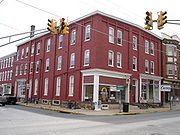
Rhoads Opera House
Encyclopedia

Boyertown, Pennsylvania
Boyertown is a borough in Berks County, Pennsylvania, United States. The population was 3,940 at the 2000 census.-Geography:According to the United States Census Bureau, the borough has a total area of , all of it land.-Demographics:...
, caught fire on January 13, 1908 during a church-sponsored stage play. The fire started when a kerosene
Kerosene
Kerosene, sometimes spelled kerosine in scientific and industrial usage, also known as paraffin or paraffin oil in the United Kingdom, Hong Kong, Ireland and South Africa, is a combustible hydrocarbon liquid. The name is derived from Greek keros...
lamp was knocked over, lighting gasoline
Gasoline
Gasoline , or petrol , is a toxic, translucent, petroleum-derived liquid that is primarily used as a fuel in internal combustion engines. It consists mostly of organic compounds obtained by the fractional distillation of petroleum, enhanced with a variety of additives. Some gasolines also contain...
from a stereoscopic machine. The stage and auditorium were located on the 2nd floor and all auxiliary exits were either unmarked or locked. One fire escape was available but unable to be accessed through a locked window above a 3 foot sill. 171 people perished when the exit was crowded against to escape the fire. Entire families were wiped out.
Aftermath
According to the Pennsylvania Department of Labor and Industry, Philadelphians contributed relief funds of $18,000. Three morgues were set up and approximately fifteen thousand people attended funerals on a single day. One hundred and five new graves were dug in Boyertown's Fairview Cemetery.In the days following the fire, Dr. Daniel Kohler, Burgess of Boyertown, appointed a relief committee, to whom the people were asked to report the names of missing persons, and who would arrange a proper and speedy burial of the dead. The Relief Committee would act in tandem with the National Bank of Boyertown (now known as National Penn Bank), to receive and distribute all contributions received from all sources. The Committee met three times a day the first weeks following the fire, once a day the next month and once a week for the next year. Irwin Ehst served as chairman, James Stauffer as secretary. On April 10, 1909, the Berks County Democrat, the newspaper published in Boyertown, PA, printed a detailed report of the income and expenditures of the Relief Committee. Total contributions received equaled $22,075.89. A total of $21,636.44 was expended. The largest contributors noted were Calvin Fegley, Treasurer of Pottstown ($2,000); Eishenlor Brothers Cigar Factory ($1,000) and Boyertown Burial Casket ($600).
The incident spurred the Pennsylvania legislature
Legislature
A legislature is a kind of deliberative assembly with the power to pass, amend, and repeal laws. The law created by a legislature is called legislation or statutory law. In addition to enacting laws, legislatures usually have exclusive authority to raise or lower taxes and adopt the budget and...
into passing new legislative standards for doors, landings, lighting, curtains, fire extinguishers, aisles, marked exits, and doors. All doors were required to open outward and remain unlocked. Pennsylvania governor Edwin Stuart signed Pennsylvania’s first fire law on May 3, 1909.
A building of apartments and stores has now been built on the former opera house's site with a plaque commemorating the tragedy.
Film
January 13, 1908, was meant to be a night to remember in Boyertown, Pennsylvania.The town was buzzing over the debut of a new play, "The Scottish Reformation," at the Rhoads Opera House. While dozens of townspeople readied for their roles as cast members, hundreds of others laid out their Sunday best in anticipation of watching the action unfold from the audience. But no one could have guessed what real life drama awaited them inside the walls of the opera house.
WFMZ-TV marked the 100th anniversary of that fateful night with a one hour documentary, "The Rhoads Opera House Fire: The Legacy of a Tragedy." It revisits the fire that killed 170 people and sparked changes in fire safety standards that still stand today. "The fire wiped out about 10 percent of the town," says WFMZ reporter Jaccii Farris, the documentary’s writer and narrator. "Nearly everyone knew someone or cared about someone who died."
The fire broke out when an actor knocked over a kerosene light on the stage. The entire opera house was engulfed in minutes. Many of the victims could not escape the flames due to the fire exits not being clearly marked. In addition, the doors of the opera house opened inward, so panicked patrons sealed their own fate when they crowded together in front of them.
Farris says the fire brought Boyertown to a standstill.
"Every day (after the fire) there were funerals and burials," she says.
The impact of the loss was woven through the entire town. Children were orphaned, and entire families were wiped out. Others had to learn to live without brothers, sisters, cousins, and friends. Farris says, in one example, a wife went to the play to surprise her husband, who was playing piano for the show.
"Unfortunately, the surprise he got was that his wife was among the dead," says Farris.
But from the ashes of tragedy came the seeds of change. The fire was the catalyst for revamping building safety regulations nationwide.
"Now, anytime you walk into a building, you’ll walk past exits signs. Fire extinguishers will be on the walls, and the doors will open outward," says Farris.

